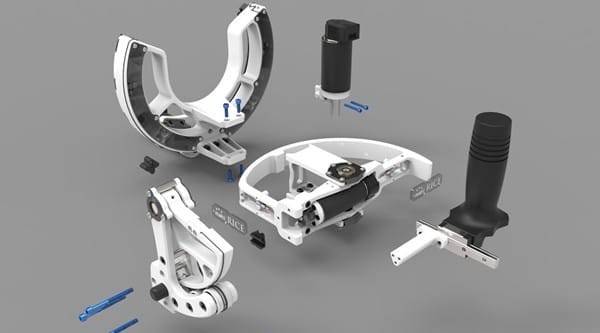Precision machining, conducted by expert CNC parts manufacturers, is essential for manufacturing exoskeleton robot parts. It’s no secret that precision machining is directly related to performance. The accuracy of the components determines the range of motion, strength augmentation, and overall user experience. Furthermore, precision machining supports advancements in design, customization, and overall innovation in the field of exoskeleton robotics.
As technology gets better and exoskeletons become more complex, precise machining becomes even more important for fully unlocking the capabilities of these advanced robotic systems.
This article provides a comprehensive guide to the precision machining process for exoskeleton robot parts, covering material selection, machining processes, precision enhancement techniques, as well as, quality control and testing methods.
Overview of Exoskeleton Robot Components
Exoskeleton robots comprise different components, from motors and sensors to actuators and frames, that work together to help users move better. Generally, the core components of a robotic exoskeleton include Structures, joints, actuators and sensors:
Structure: The exoskeleton’s mechanical structure is a rigid framework that aligns with the user’s skeletal structure to amplify human movement.
Actuators and Motors: The exoskeleton’s movements are powered by actuators, motors that convert electrical energy into mechanical motion. These actuators are strategically placed at each joint, providing the torque needed to assist movement.
Sensors and Electronics: Exoskeleton sensors and electronics provide real-time feedback on movements, environment, and internal state.
Control System (Computer and Software): The exoskeleton’s control system acts as its brain, interpreting sensor data, making decisions, and issuing commands to the actuators.
These components must be precisely machined to meet the strict demands of exoskeleton robots. Precision is key to ensuring proper fit, functionality, and overall performance of these mechanical systems.
Machining Techniques for Exoskeleton Robot Parts
Exoskeleton robots require diverse machining techniques to produce the high-precision parts they demand. Newer technologies like computer numerical control (CNC) machining and additive manufacturing (3D printing) have produced accurate and efficient exoskeleton design and manufacturing. CNC machining allows for exact and automated production, while additive manufacturing enables complex geometries and customization.

Machined parts form the structural framework of the exoskeleton, providing support, stability, and load-bearing capabilities. Components like joints, limb supports, frames, and connectors are precisely manufactured to ensure strength and durability, maintaining the overall stability of the exoskeleton. The intricate design and precision of machined parts ensure seamless integration and precise fit within the exoskeleton mechanism. Parts are engineered with tolerances and dimensions that align precisely with other components, allowing for smooth movements and optimal functionality of the mechanism.
Machined parts are designed to efficiently distribute loads and transmit forces within the exoskeleton mechanism. Load-bearing components, often made from durable materials like titanium or carbon fiber composites, ensure that forces applied by the wearer are effectively managed without compromising the structure’s integrity. Critical components such as joints and articulating segments are meticulously machined to facilitate natural human movement. These parts enable the exoskeleton to replicate joint motions and provide support in a way that aligns with the wearer’s anatomy, enhancing mobility and agility.
Machined parts are the foundation of the exoskeleton mechanism, providing structural support, articulation, load distribution, and user comfort. Their precision and integration within the system are essential for ensuring the seamless operation and adaptability of these advanced assistive devices.
Considerations in Exoskeleton Robot Part Machining
Machining these components involves specialized techniques and considerations tailored to meet the exacting requirements of these sophisticated assistive devices.
Material Selection
Choosing the right materials for exoskeleton components is foundational. Factors such as strength, durability, and weight play a pivotal role in determining the performance and usability of these devices. Materials like carbon fiber composites and titanium alloys are often preferred due to their exceptional strength-to-weight ratio and durability.
Carbon fiber composites are ideal for constructing lightweight yet robust exoskeleton components. Their inherent high tensile strength, stiffness, and corrosion resistance contribute to their popularity in critical parts like limb supports or structural elements. The high tensile strength ensures the structural integrity of exoskeleton components. Despite their lightweight nature, these materials provide the necessary support for limbs, joints, and load-bearing structural elements. This strength allows for the creation of parts capable of withstanding significant mechanical stress without compromising on weight. Carbon fiber composites exhibit contribute to the stability and responsiveness of exoskeleton components.
Titanium alloys are another preferred choice for exoskeleton parts due to their impressive strength, corrosion resistance, and biocompatibility. Their compatibility with the human body makes them suitable for components requiring direct interaction with the wearer’s skin, ensuring minimal risk of allergic reactions or discomfort.
The selection of materials for exoskeleton components involves a delicate balance between strength, weight, durability, and biocompatibility. Each material choice impacts the overall performance and functionality of these assistive devices, ensuring they meet the stringent requirements for supporting human mobility and enhancing quality of life.
Tolerances and Precision
Exoskeleton parts necessitate ultra-precise machining with minimal tolerances. Achieving the required precision is crucial for ensuring seamless integration of components, facilitating natural movement, and guaranteeing user comfort.
The level of precision achieved in machining exoskeleton parts significantly influences user comfort and safety. Smooth and precisely manufactured components reduce the risk of friction, pressure points, or discomfort during prolonged wear. Additionally, the elimination of uneven surfaces or misalignments enhances the exoskeleton’s safety, minimizing the risk of mechanical failures or accidents.
Surface Finish and Quality Control
The surface finish of machined parts is critical for both functionality and aesthetics. Strict quality control measures during machining are essential to guarantee the integrity and reliability of these vital components.

Ergonomics and Biomechanics
Machined parts in exoskeleton robots must be designed with human biomechanics in mind. Ergonomic considerations ensure a natural fit, comfort, and optimized movement, mimicking the body’s natural motion to enhance user experience.
Machining parts for exoskeleton robots demands a delicate balance between precision, material selection, and design considerations. Attention to these multifaceted factors ensures the production of reliable, functional, and user-centric components crucial for the effectiveness of these groundbreaking assistive devices.
Conclusion
Manufacturing high-precision exoskeleton robot parts is a complex and demanding endeavor that requires a deep understanding of material selection, machining processes, and quality control and testing measures. By following these guidelines, engineers and researchers can create exoskeleton parts that are very precise, reliable, and perform well.




